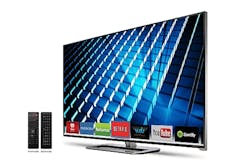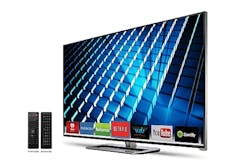While the TV and display backlighting application segment had driven the biggest volume of LED sales prior to 2013, the number of LEDs used in the TV segment has leveled off with the advent of brighter LEDs and edge-lighting techniques. Vizio, however, has just announced the M-Series of TVs with what the company refers to as Full-Array LED backlighting. Indeed, the potential to enhance images with more LEDs and dynamic control of light levels could lead to another ramp in LED usage by TV makers.
One major advantage of LED backlighting has been dynamic control of the light level for relatively small areas of the overall display. TV manufacturers add control schemes, sometimes called local dimming, that can match the LED light level to the content of specific areas of each frame in a video stream, effectively increasing the contrast ratio. Vizio specification sheets list a dynamic contrast ratio of 20 million to one for the new M-Series models.
The M-Series TVs includes as many as 36 separate LED zones depending on screen size. "The VIZIO M-Series collection represents a significant milestone in picture quality for mainstream consumers," said Matt McRae, CTO of Vizio. "We crafted a best-in-class experience by increasing brightness, doubling the number of Active LED Zones and boosting the Clear Action performance." The Clear Action feature refers to the 240-Hz refresh rate and image processing features meant to eliminate artifacts in fast motion scenes.
The array-style backlighting has fallen out of favor with some TV makers and consumers as the trend toward thinner edge-lit sets has made inroads in the market. But edge lighting limits the ability to effectively dim small areas of the screen. Consumers that care more about picture quality will be drawn to the slightly thicker sets with more backlighting, and more zones and LEDs utilized equates to better images. The new M-Series sets are still around 2-in. thin depending on screen size.
The edge-lit trend has been partially responsible for the fact that the LEDs consumed in the TV market has gone from a steep ramp to even a decline in terms of packaged LED revenue attributable to the market. For more information on the market, see our report covering presentations by Strategies Unlimited analysts made at the Strategies in Light conference back in February.
There had also been a trend by some TV manufacturers to build thicker TVs that were able to use fewer brighter LEDs for backlighting. We covered that concept in our Strategies in Light 2013 report. Such thicker TVs would enable lower price points but would not deliver the image-quality benefits of local dimming.
The market, however, appears to prefer the superior performance of TVs with local dimming and more granular zone control. Strategies Unlimited said in February that the revenue from packaged LEDs sold into the TV market would decline at a compound annual growth rate of 7.74%. That decline doesn’t equate to significantly fewer LEDs being used so much as it does to price drops in LEDs used for backlighting. Still, it will be interesting to see how the latest TV trends might affect the forecasts as they are updated in the next year.






